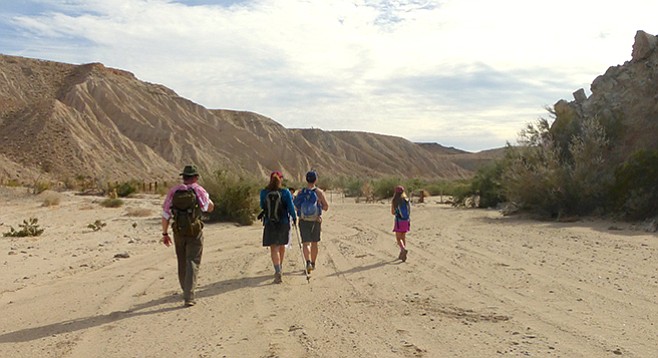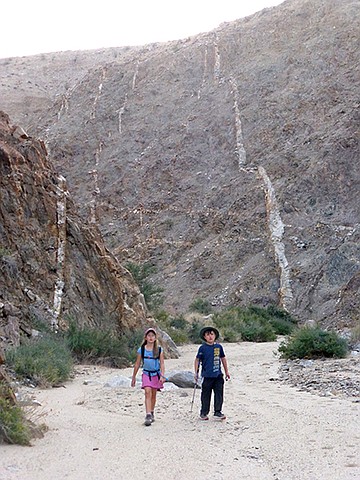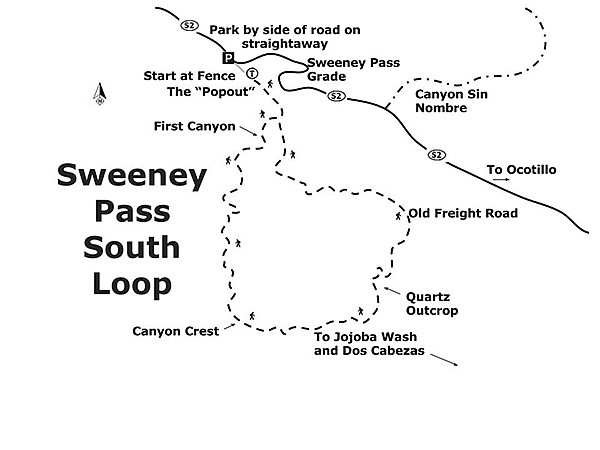 Facebook
Facebook
 X
X
 Instagram
Instagram
 TikTok
TikTok
 Youtube
Youtube

Sweeney Wash and Canyon is located in the Elsinore Fault Zone. Look forward to viewing twisted and turned pegmatite dikes along this hike that reflect Cretaceous tectonic forces in play. The wash may be part of an old freight road between Dos Cabezas, the Dolomite Mine, and the road to Julian that was used many years before the Sweeney Pass Road was constructed. The beginning of this hike was the “Popout” mentioned by guidebook author Horace Parker in his Anza-Borrego Desert Guidebook, originally published in 1957.

Sweeney Pass was always a barrier to most vehicles following the old Imperial Highway in the 1930s and 1940s. San Diego County engineers constructed the current route in 1952 that enables conventional vehicles to negotiate the sinuous route that snakes up the hillsides.
There is some confusion as to the origin of the name of the pass. It was possibly named for Lt. Thomas W. Sweeny, who came to California after the Mexican-American War and was assigned to San Diego. He traveled the route over Sweeney Pass when he became the head of Camp Independence on the Gila River. If named for him, then the pass has been misspelled. Another possibility is that the pass was named for a member of the Sweeney family of Imperial County. Oscar Sweeney established the Seeley Sentinel in 1913 and other members of the family were involved in Imperial County businesses and were active in the historical societies.

Begin the hike in the sandy wash at the fence, which is at the bottom of the Sweeney Pass Grade, and head southeast. Follow the first canyon to the right that heads south. The canyon will narrow, twist, and turn, and eventually head east where it will crest and open up to Jojoba Wash, which leads to Dos Cabezas. Boulders, a small dry waterfall, and rocks in the canyon will slow progress. As the canyon opens up, look to the left (northeast) for a low point on the ridge.
After you work your way up the ridge from the canyon, the route leads to a mesa and an overview of Jojoba Wash. Begin working your way northeast over the mesa and down to a small wash that will lead to the north over a pass and back down to Sweeney Wash. Look for a highly visible quartz-covered outcrop to the north that marks the direction of the route leading back to Sweeney Wash. Carefully work your way down boulders and dry waterfalls to the wash below. You are now following another possible route of the old freight road. Continue west and then northwest to where it opens up. You will note your original entry into the canyon on your left. Follow the wash back out to the fence and your parked vehicle.
Typical plants that may be encountered on this hike include brittlebush, teddy-bear cholla, catclaw acacia, creosote, ocotillo, desert tobacco, chuparoa, desert lavender, white-stemmed milkweed, thick-leaved ground cherry, and both species of purplish-cast krameria with their grayish green leaves and orchid-like flowers — white rhatany and pima rhatany. Check the spherical fruit of krameria to identify the species of this semi-parasite. The fruit of both plants looks like a medieval mace. The white rhatany fruit is round and has barbed-tipped spines while the pima rhatany is more heart-shaped and its spines are erect with no barbs at the end.

Look closely at the various pegmatite dikes found on this hike — twisted and turned in every direction by earth movement in the Elsinore Fault Zone. The dikes are formed underground when igneous rock is cooling and forms cracks allowing molten material to squeeze into the cracks. Sandwiched between cooler rocks, the molten material takes longer to cool, allowing like minerals to develop. Look for common minerals like quartz, mica, feldspar, and black tourmaline (schorl) in these pegmatite dikes.
(Anza-Borrego Desert State Park)
Driving directions: From Julian, drive east on SR-78, 11.8 miles to the junction with S-2 at Scissors Crossing. Turn south on S-2, drive 31.7 miles to the bottom of the Sweeney Pass Grade near milepost 49.9, parking along the straightaway. From Ocotillo, drive north 15.9 miles on S-2 to the bottom of the Sweeney Pass Grade and park along the straightaway. Allow two hours driving time from the San Diego metropolitan area.
Hiking length: 6.8 miles. Allow four hours.
Difficulty: Moderate. Elevation gain/loss: 430 feet. High point is 1286 feet.


Sweeney Wash and Canyon is located in the Elsinore Fault Zone. Look forward to viewing twisted and turned pegmatite dikes along this hike that reflect Cretaceous tectonic forces in play. The wash may be part of an old freight road between Dos Cabezas, the Dolomite Mine, and the road to Julian that was used many years before the Sweeney Pass Road was constructed. The beginning of this hike was the “Popout” mentioned by guidebook author Horace Parker in his Anza-Borrego Desert Guidebook, originally published in 1957.

Sweeney Pass was always a barrier to most vehicles following the old Imperial Highway in the 1930s and 1940s. San Diego County engineers constructed the current route in 1952 that enables conventional vehicles to negotiate the sinuous route that snakes up the hillsides.
There is some confusion as to the origin of the name of the pass. It was possibly named for Lt. Thomas W. Sweeny, who came to California after the Mexican-American War and was assigned to San Diego. He traveled the route over Sweeney Pass when he became the head of Camp Independence on the Gila River. If named for him, then the pass has been misspelled. Another possibility is that the pass was named for a member of the Sweeney family of Imperial County. Oscar Sweeney established the Seeley Sentinel in 1913 and other members of the family were involved in Imperial County businesses and were active in the historical societies.

Begin the hike in the sandy wash at the fence, which is at the bottom of the Sweeney Pass Grade, and head southeast. Follow the first canyon to the right that heads south. The canyon will narrow, twist, and turn, and eventually head east where it will crest and open up to Jojoba Wash, which leads to Dos Cabezas. Boulders, a small dry waterfall, and rocks in the canyon will slow progress. As the canyon opens up, look to the left (northeast) for a low point on the ridge.
After you work your way up the ridge from the canyon, the route leads to a mesa and an overview of Jojoba Wash. Begin working your way northeast over the mesa and down to a small wash that will lead to the north over a pass and back down to Sweeney Wash. Look for a highly visible quartz-covered outcrop to the north that marks the direction of the route leading back to Sweeney Wash. Carefully work your way down boulders and dry waterfalls to the wash below. You are now following another possible route of the old freight road. Continue west and then northwest to where it opens up. You will note your original entry into the canyon on your left. Follow the wash back out to the fence and your parked vehicle.
Typical plants that may be encountered on this hike include brittlebush, teddy-bear cholla, catclaw acacia, creosote, ocotillo, desert tobacco, chuparoa, desert lavender, white-stemmed milkweed, thick-leaved ground cherry, and both species of purplish-cast krameria with their grayish green leaves and orchid-like flowers — white rhatany and pima rhatany. Check the spherical fruit of krameria to identify the species of this semi-parasite. The fruit of both plants looks like a medieval mace. The white rhatany fruit is round and has barbed-tipped spines while the pima rhatany is more heart-shaped and its spines are erect with no barbs at the end.

Look closely at the various pegmatite dikes found on this hike — twisted and turned in every direction by earth movement in the Elsinore Fault Zone. The dikes are formed underground when igneous rock is cooling and forms cracks allowing molten material to squeeze into the cracks. Sandwiched between cooler rocks, the molten material takes longer to cool, allowing like minerals to develop. Look for common minerals like quartz, mica, feldspar, and black tourmaline (schorl) in these pegmatite dikes.
(Anza-Borrego Desert State Park)
Driving directions: From Julian, drive east on SR-78, 11.8 miles to the junction with S-2 at Scissors Crossing. Turn south on S-2, drive 31.7 miles to the bottom of the Sweeney Pass Grade near milepost 49.9, parking along the straightaway. From Ocotillo, drive north 15.9 miles on S-2 to the bottom of the Sweeney Pass Grade and park along the straightaway. Allow two hours driving time from the San Diego metropolitan area.
Hiking length: 6.8 miles. Allow four hours.
Difficulty: Moderate. Elevation gain/loss: 430 feet. High point is 1286 feet.
Comments